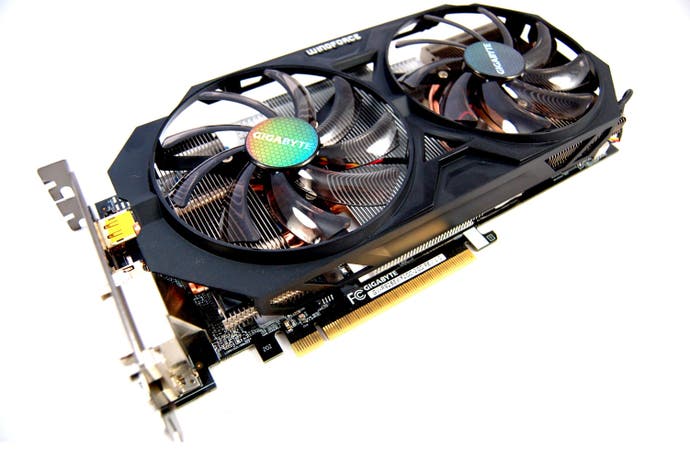Radeon R9 285 review
AMD strikes a sweet spot in price vs performance.
The sub-£200/$300 graphics card market is fiercely contested - and for good reason. It's at this point that we see the best balance between price and performance for the core gamer, and recently both Nvidia's GeForce GTX 760 and AMD's Radeon R9 280 have offered excellent value. Both cards can run just about any game you care to mention maxed out at 1080p with creditable frame-rates. AMD's aim with the new R9 285 is simple - to make its product cheaper, easier to produce and more power-efficient. In short, with its new 'Tonga' design it wants to eliminate the inefficiencies from the old Tahiti chip that powers the 280 and at the same time take down its Nvidia rival. By and large, we'd say AMD has succeeded.
A visual inspection of the R9 285 demonstrates that, in terms of physical construction, it's considerably simpler and indeed smaller than its predecessor. Efficiency wise, the daunting 250W TDP of the R9 280 has been reduced to a more palatable 190W. That's still 20W more than the GTX 760, but the reduced requirements made on your PSU are welcome nonetheless - just two six-pin power connections are required, rather than the six-pin/eight-pin combo found on the R9 280.
The revised design does come with some potential negatives, however. Most notably, the 384-bit memory bus that served the Tahiti cards so well in keeping up with their Nvidia competitors is gone, reduced to the same 256-bit bus as the GTX 760. This has a knock-on effect on something that could prove crucial going forward - the minimum 3GB of GDDR5 that comes as standard with every R9 280 is gone, reduced to 2GB with 4GB options available at a premium, just like its Nvidia competitor. Clock speeds are also slightly reduced from the older R9 280.
There's also been some rationalisation of the back-plate too. Tahiti cards typically shipped with one or two dual-link DVI sockets, HDMI and twin MiniDisplayPorts. Here, the R9 285 falls into line with the GTX 760: we get the standard DVIs, HDMI and the larger DisplayPort connection. It's worth pointing out that our review sample isn't an AMD reference card - the firm supplied us with a Gigabyte 'Windforce' variant, with a mild 55MHz overclock, taking us up from the stock 918MHz boost speed to 973MHz. However, stock RAM speeds are unchanged from the standard design at 1375MHz (5.5GHz effective).
The timing of the R9 285's release is interesting. GPU chips have been manufactured at 28nm since the tail end of 2011. The expectation has been that the new line of graphics cards would debut on the smaller 20nm process, but for whatever reason the transition to 20nm has been delayed. To get the best out of the existing manufacturing technologies, AMD has had to adapt - it simply can't rely on its foundries to hand in smaller chips. In this respect, Nvidia is already ahead of the curve - its Kepler architecture has battled with AMD's current-gen chips in terms of performance, but it has always achieved its results with a greater degree of efficiency. With the recent launch of the GTX 750 Ti, it's also ahead in terms of extracting more from the 28nm process thanks to its new design, codenamed Maxwell. So, can AMD follow suit?
Life for AMD and Nvidia beneath the £200/$300 threshold is daunting. These are the cards that we expect to cope with the latest and greatest games at max settings. It's also where we need to see AMD deal a decisive blow against Nvidia - for too long the two firms have handed in mostly equivalent performance for the same ballpark prices. This is a sector of the market where the users are highly educated and will only buy the best. Bearing in mind the drive for efficiency, a straight re-run of R9 280 (which, let's not forget, is essentially a re-spun Radeon HD 7950) simply won't cut the mustard.
We kick off with our benchmark suite running a range of modern titles at 1080p resolution with maximum settings ramped up - typically the first instinct an enthusiast has when putting their new GPU through its paces. Comparison points here are no-brainers - in an ideal world, we want to see the R9 285 beat the outgoing R9 280, and we want to see it give the faster, more powerful R9 280X a run for its money. At the same time, we really need to see whether AMD's new Tonga design has indeed beaten off the challenge of the GTX 760. Furthermore, what about overclocking? We've got that covered too.
Additional benchmarks:
| 1920x1080 | R9 285 | R9 285 OC | R9 280X | R9 280 | GTX 760 |
|---|---|---|---|---|---|
| BioShock Infinite, DX11 Ultra DDOF | 79.0 | 83.7 | 81.2 | 64.9 | 70.6 |
| Tomb Raider, Ultra, FXAA | 87.3 | 94.1 | 100 | 84.7 | 77.9 |
| Battlefield 4 Ultra | 46.8 | 49.3 | 52.9 | 45.7 | 44.5 |
| Metro: Last Light, Very High, SSAA | 32.2 | 33.6 | 45.3 | 30.2 | 27.8 |
| Crysis 3, Very High | 49.2 | 50.7 | 51.5 | 43.9 | 43.4 |
It's a pretty conclusive - if not entirely spectacular - win over the GTX 760, with an average boost of 11.6 per cent over the Nvidia card, and a 9.2 per cent increase over the R9 280. Hopes that the 285 would match the older 280X are dashed - on average it is still 17.8 per cent faster, though overclocking can make up most of the difference in some but not all of the games we tested. As it is, overclocking the R9 285 is fairly simple - just don't use the supplied Catalyst Control Centre, go for something like MSI Afterburner instead (CCC actually locked in a bad overclock that prevented us from successfully rebooting our review system). Ramp up the power delivery to 120 per cent, then experiment in pushing core and memory frequencies. We could push RAM from its default 1375MHz to 1525MHz (6.1GHz effective) and core clock was solid at 1050MHz, up from the reference standard 918MHz. The Windforce cooler from Gigabyte served us well here, with the card remaining whisper quiet throughout - a far cry from some of the old Tahiti products we've tested in the past.
This tier of graphics card is pretty much entry-level if you're considering gaming at 2560x1440 (1440p if you will). Certainly, AMD is marketing the R9 285 as a product aimed at getting the most out of full HD - and that's where the vast majority of the gaming market sits. However, we found that it's perfectly serviceable for 2.5K gaming, as long as you are responsible with your quality presets. What we've done for this second round of benchmarks is to lower presets down from ultra to the next lowest quality level, and toned down any inappropriate anti-aliasing or tessellation settings. In truth, for many titles, that may actually be a decent course of action for 1080p gaming - as you'll see from the table, computational requirements go stratospheric at the ultra level. Toning down presets can see huge leaps in frame-rate, without a huge impact to quality.
The results here are fascinating. We see a clear 15 per cent boost over the GTX 760, but the average boost over the R9 280 is reduced to just 6.9 per cent. The older, wider memory bus on the Tahiti chip has always served AMD well when it comes to 2.5K resolutions, so the drop is expected but the fact that the R9 285 remains competitive is pretty impressive. The BioShock results in particular stand out - here the 285 at stock speeds is duking it out with the more powerful 280X, which sees its overall advantage whittled down to 9.6 per cent.
| 2560x1440 | R9 285 | R9 285 OC | R9 280X | R9 280 | GTX 760 |
|---|---|---|---|---|---|
| BioShock Infinite, Very High | 76.0 | 80.7 | 75.8 | 65.0 | 60.4 |
| Tomb Raider, High, FXAA | 76.1 | 81.1 | 90.7 | 76.9 | 73.9 |
| Battlefield 4 High | 51.7 | 54.7 | 56.7 | 48.9 | 45.1 |
| Metro: Last Light, High, No SSAA | 42.6 | 45.1 | 45.3 | 39.0 | 35.0 |
| Crysis 3, High | 48.2 | 49.2 | 54.3 | 46.5 | 44.2 |
The benchmark statistics are undeniably impressive overall. We might have expected the reduced memory and lower bandwidth to have an impact at higher resolutions, but even here the R9 285 manages to beat out its predecessor, also registering an increase on titles where the wider memory bus has historically helped Radeon performance a great deal - for example, in Metro Last Light.
Boosting memory and core clocks on the R9 285 impacts different games in different ways. For example, BioShock Infinite running on an overclocked card can beat the R9 280X - a pretty impressive feat. However, across our testing overall we're looking at just a 5.3 per cent increase in performance at both 1080p and 1440p. That's a nice bonus (one which would be larger compared to a card at stock, reference settings) but hardly a revelation.
So how does all of this translate into gameplay? Crysis 3 remains the most stringent of tests, and its "Welcome to the Jungle" stage is particularly taxing test on its high setting (that's considerably less taxing than the very high preset) - which we enable in order to try our luck in achieving something close to a 60fps gaming experience. We played through the same level three times, stacking up the R9 285 with the GTX 760 and the now-replaced R9 280. The end result shows that the new AMD card does indeed get the better of both of its competitors, hitting 60fps far more consistently than its rivals. None of the cards are able to hit that 60fps lock, but clearly the R9 285 gets closest.
AMD tells us that the 2GB R9 285 will debut in the UK at £169.99 - just a little more expensive than the ballpark price you'll pay these days for a GTX 760. We aren't looking at a truly transformative improvement to performance compared to the Nvidia card, so right now you essentially pay a small premium for the extra performance. However, short of an official price cut from the green team, we suspect that R9 285 prices will equalise with its competitor sooner rather than later. In the meanwhile, we've already seen the departing R9 280 priced as low as £150 - that's a phenomenal deal for a card that may not match the 285's raw performance, but can fall back on its additional 1GB of GDDR5. Either way it looks like AMD is beginning to exert dominance over this very important market sector.
But it's in the memory department that we begin to move into uncharted territory. Next-gen console is already beginning to impact PC games development. Watch Dogs still has major performance issues, exacerbated on 2GB cards - 3GB is the bare minimum for running on maximum settings (and even then, serious issues remain). In the meantime, Titanfall also sees performance dips on 2GB cards owing to its habit of loading all textures into RAM with no background streaming. That's no problem for 3GB cards (or indeed the new consoles) but it is an issue for PCs with 2GB video cards, necessitating a settings tweak to texture quality to restore performance. We suspect that games like this are just the beginning - it's just a shame that there are no taxing, easily repeatable gameplay segments we can use to demonstrate that difference in the here and now. The R9 285 will be available in both 2GB and 4GB configurations: for the sake of future-proofing, we'd have to opt for the larger, more expensive card. And that makes end-of-line R9 280s offered at a cut-down price look even more attractive, since every last one of them has at least 3GB of RAM.
As a final test, we wanted to look into the Tonga chipset's efficiency improvements. The performance arguments are settled, but we were interested to see how much juice each of our test GPUs took from the wall. The R9 285's TDP drop down to 190W suggests a huge improvement over the R9 280, but the reality turned out to be rather less exciting. Our ability to measure overall power consumption is limited at the moment, so right now we are only able to show peak draw. The end result is that we do see higher performance with less power required, but there is no revelatory increase in overall efficiency. Based on the Metro Last Light benchmarking test - which sees GPU load hit 100 per cent - the R9 280X draws a little more power than the R9 280, which in turn is just a little greedier than the R9 285. Nvidia may not have won the performance crown this time around, but based on our observations, it draws a good 20-25W less juice. Our test system here features 16GB of DDR3 and a Core i7-3770K overclocked to 4.3GHz (though we should point out that no additional power was required to achieve that).
| R9 285 | R9 285 OC | R9 280X | R9 280 | GTX 760 | |
|---|---|---|---|---|---|
| Peak System Power Draw | 270W | 280W | 278W | 277W | 249W |
Radeon R9 285 - the Digital Foundry verdict
Has AMD beaten Nvidia at its own game in terms of power and efficiency? Well, AMD has taken a clear performance lead in this hotly contested market sector - a differential that can be felt in gameplay, and arguably that's the most important thing. The fact that the firm has been able to deliver that performance increase while paring back the memory bus and lowering clocks a touch is a significant achievement. However, while the Tonga GPU has delivered the raw frame-rates, the chip is still pretty power-hungry - not that this tends to influence gamers that much, but it could have an impact on smaller form factor PCs.
What's also noteworthy about the R9 285 is that AMD hasn't just targeted performance leadership - it has attempted to retain its trademark value too. Launch pricing is reasonable, and the Never Settle gaming bundle has also been extended, with R9 285 purchasers able to select three games out of a hefty bundle including the upcoming Alien: Isolation and Star Citizen (this same bundle applies to R9 280 and other high-end Radeon GPUs too). It's also worth remembering that this is a modern GCN chip - meaning that the TrueAudio hardware is also included, though software support remains fairly limited there.
Overall, it's difficult not to be impressed with the R9 285, and the arrival of the new Tonga chip suggests more to come - a fully unlocked version of the processor must surely debut as a new R9 285X in the coming weeks. In the meantime, it will be fascinating to see how Nvidia responds to this product. The first card based on its Maxwell architecture was aimed at an entirely different market sector, but the foundations were laid for more potent products - and we hope to see them arrive sooner rather than later.








